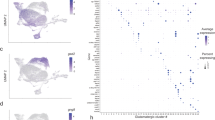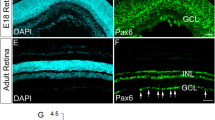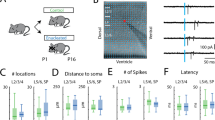Abstract
In mammals, retinal ganglion cell (RGC) projections initially intermingle and then segregate into a stereotyped pattern of eye-specific layers in the dorsal lateral geniculate nucleus (dLGN). Here we found that in mice deficient for ephrin-A2, ephrin-A3 and ephrin-A5, eye-specific inputs segregated but the shape and location of eye-specific layers were profoundly disrupted. In contrast, mice that lacked correlated retinal activity did not segregate eye-specific inputs. Inhibition of correlated neural activity in ephrin mutants led to overlapping retinal projections that were located in inappropriate regions of the dLGN. Thus, ephrin-As and neural activity act together to control patterning of eye-specific retinogeniculate layers.
This is a preview of subscription content, access via your institution
Access options
Subscribe to this journal
Receive 12 print issues and online access
$209.00 per year
only $17.42 per issue
Buy this article
- Purchase on Springer Link
- Instant access to full article PDF
Prices may be subject to local taxes which are calculated during checkout





Similar content being viewed by others
References
Feldheim, D.A. et al. Genetic analysis of ephrin-A2 and ephrin-A5 shows their requirement in multiple aspects of retinocollicular mapping. Neuron 25, 563–574 (2000).
Feldheim, D.A. et al. Topographic guidance labels in a sensory projection to the forebrain. Neuron 21, 1303–1313 (1998).
Feldheim, D.A. et al. Loss-of-function analysis of EphA receptors in retinotectal mapping. J. Neurosci. 24, 2542–2550 (2004).
Vanderhaeghen, P. & Polleux, F. Developmental mechanisms patterning thalamocortical projections: intrinsic, extrinsic and in between. Trends Neurosci. 27, 384–391 (2004).
McLaughlin, T., Hindges, R. & O'Leary, D.D. Regulation of axial patterning of the retina and its topographic mapping in the brain. Curr. Opin. Neurobiol. 13, 57–69 (2003).
Metin, C., Godement, P., Saillour, P. & Imbert, M. [Physiological and anatomical study of the retinogeniculate projections in the mouse.] C. R. Seances Acad. Sci. III 296, 157–162 (1983).
Rossi, F.M. et al. Requirement of the nicotinic acetylcholine receptor beta 2 subunit for the anatomical and functional development of the visual system. Proc. Natl. Acad. Sci. USA 98, 6453–6458 (2001).
Sretavan, D.W., Shatz, C.J. & Stryker, M.P. Modification of retinal ganglion cell axon morphology by prenatal infusion of tetrodotoxin. Nature 336, 468–471 (1988).
Shatz, C.J. & Stryker, M.P. Prenatal tetrodotoxin infusion blocks segregation of retinogeniculate afferents. Science 242, 87–89 (1988).
Penn, A.A., Riquelme, P.A., Feller, M.B. & Shatz, C.J. Competition in retinogeniculate patterning driven by spontaneous activity. Science 279, 2108–2112 (1998).
Sretavan, D.W. & Shatz, C.J. Prenatal development of retinal ganglion cell axons: segregation into eye-specific layers within the cat's lateral geniculate nucleus. J. Neurosci. 6, 234–251 (1986).
Rakic, P. Development of visual centers in the primate brain depends on binocular competition before birth. Science 214, 928–931 (1981).
Godement, P., Salaun, J. & Metin, C. Fate of uncrossed retinal projections following early or late prenatal monocular enucleation in the mouse. J. Comp. Neurol. 255, 97–109 (1987).
Stellwagen, D. & Shatz, C.J. An instructive role for retinal waves in the development of retinogeniculate connectivity. Neuron 33, 357–367 (2002).
Crowley, J.C. & Katz, L.C. Ocular dominance development revisited. Curr. Opin. Neurobiol. 12, 104–109 (2002).
Huberman, A.D. et al. Eye-specific retinogeniculate segregation independent of normal neuronal activity. Science 300, 994–998 (2003).
Muir-Robinson, G., Hwang, B.J. & Feller, M.B. Retinogeniculate axons undergo eye-specific segregation in the absence of eye-specific layers. J. Neurosci. 22, 5259–5264 (2002).
Huberman, A.D., Stellwagen, D. & Chapman, B. Decoupling eye-specific segregation from lamination in the lateral geniculate nucleus. J. Neurosci. 22, 9419–9429 (2002).
Shatz. Emergence of order in visual system development. Proc. Natl. Acad. Sci. USA 93, 602–608 (1996).
Crowley, J.C. & Katz, L.C. Development of ocular dominance columns in the absence of retinal input. Nat. Neurosci. 2, 1125–1130 (1999).
Chapman, B. Necessity for afferent activity to maintain eye-specific segregation in ferret lateral geniculate nucleus. Science 287, 2479–2482 (2000).
Frisén, J. et al. Ephrin-A5 (AL-1/RAGS) is essential for proper retinal axon guidance and topographic mapping in the mammalian visual system. Neuron 20, 235–243 (1998).
Cutforth, T. et al. Axonal ephrin-As and odorant receptors: coordinate determination of the olfactory sensory map. Cell 114, 311–322 (2003).
Flanagan, J.G. & Vanderhaeghen, P. The ephrins and Eph receptors in neural development. Annu. Rev. Neurosci. 21, 309–345 (1998).
Grubb, M.S., Rossi, F.M., Changeux, J.P. & Thompson, I.D. Abnormal functional organization in the dorsal lateral geniculate nucleus of mice lacking the beta 2 subunit of the nicotinic acetylcholine receptor. Neuron 40, 1161–1172 (2003).
Adams, D.L. & Horton, J.C. Capricious expression of cortical columns in the primate brain. Nat. Neurosci. 6, 113–114 (2003).
Williams, S.E. et al. Ephrin-B2 and EphB1 mediate retinal axon divergence at the optic chiasm. Neuron 39, 919–935 (2003).
Pham, T.A., Rubenstein, J.L., Silva, A.J., Storm, D.R. & Stryker, M.P. The CRE/CREB pathway is transiently expressed in thalamic circuit development and contributes to refinement of retinogeniculate axons. Neuron 31, 409–420 (2001).
Huh, G.S. et al. Functional requirement for class I MHC in CNS development and plasticity. Science 290, 2155–2159 (2000).
Hanson, M.G. & Landmesser, L.T. Normal patterns of spontaneous activity are required for correct motor axon guidance and the expression of specific guidance molecules. Neuron 43, 687–701 (2004).
Demas, J., Eglen, S.J. & Wong, R.O. Developmental loss of synchronous spontaneous activity in the mouse retina is independent of visual experience. J. Neurosci. 23, 2851–2860 (2003).
Huberman, A.D., Murray, K.D., Warland, D.K., Feldheim, D.A. & Chapman, B. Ephrin-As mediate targeting of eye-specific projections to the lateral geniculate nucleus. Nat. Neurosci. 8, 1011–1019 (2005).
Flanagan, J.G. In situ analysis of embryos with receptor or ligand fusion protein probes. Curr. Biol. 10, R52–R53 (2000).
Tian, N. & Copenhagen, D.R. Visual stimulation is required for refinement of ON and OFF pathways in postnatal retina. Neuron 39, 85–96 (2003).
Wong, R.O.L., Meister, M. & Shatz, C.J. Transient period of correlated bursting activity during development of the mammalian retina. Neuron 11, 923–938 (1993).
Acknowledgements
We thank B. Chapman and A. Huberman for discussions and sharing data prior to publication. We thank C. Chen, P. Vanderhaeghen and C. Mason for discussions and critical reading of the manuscript and R. Axel for support (T.C.). This work was supported by a US National Institutes of Health (NIH) grant EY014689 (D.A.F.), an NIH predoctoral training grant GM08646 (C.P.) and NIH grants R01 DC04209 and P01 CA23767 (T.C.).
Author information
Authors and Affiliations
Corresponding author
Ethics declarations
Competing interests
The authors declare no competing financial interests.
Supplementary information
Supplementary Fig. 1
No qualitative difference in EphA receptor expression in the retina or dLGN at P6 after epibatidine injection into the eye. (PDF 4256 kb)
Supplementary Fig. 2
Stereotypical and bilaterally symmetric defects of ipsilateral projections to the dLGN in ephrin-A2/A3/A5 triply mutant mice. (PDF 2291 kb)
Supplementary Fig. 3
Normal optic chaism crossing in ephrin-A2/A3/A5 triple mutant mice. (PDF 1719 kb)
Supplementary Fig. 4
Two step mechanism for retinogeniculate map development. (PDF 1226 kb)
Supplementary Video 1
Movie of stacked 10μm confocal optical sections demonstrating the continuous ipsilateral layer in the wild-type adult dLGN. Axons from the ipsilateral eye are shown in green, axons from the contalateral eye are shown in red. The movie progresses from the most anterior section to the most posterior. Dorsal is to the top, lateral is to the right. (AVI 22276 kb)
Supplementary Video 2
Movie of stacked 10μm confocal optical sections demonstrating the continuous, yet branching structure of the ipsilateral layer in an ephrin-A2/A3/A5 triply mutant adult dLGN. Axons from the ipsilateral eye are shown in green, axons from the contralateral eye are shown in red. The movie progresses from the most anterior section to the most posterior. Dorsal is to the top, lateral is to the right. (AVI 40709 kb)
Rights and permissions
About this article
Cite this article
Pfeiffenberger, C., Cutforth, T., Woods, G. et al. Ephrin-As and neural activity are required for eye-specific patterning during retinogeniculate mapping. Nat Neurosci 8, 1022–1027 (2005). https://doi.org/10.1038/nn1508
Received:
Accepted:
Published:
Issue Date:
DOI: https://doi.org/10.1038/nn1508
This article is cited by
-
Identification of age-specific gene regulators of La Crosse virus neuroinvasion and pathogenesis
Nature Communications (2023)
-
Modular strategy for development of the hierarchical visual network in mice
Nature (2022)
-
Cholinergic neural activity directs retinal layer-specific angiogenesis and blood retinal barrier formation
Nature Communications (2019)
-
Molecular guidance cues in the development of visual pathway
Protein & Cell (2018)
-
Downstream mediators of Ten-m3 signalling in the developing visual pathway
BMC Neuroscience (2017)



